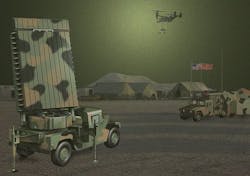Officials of the Marine Corps Systems Command at Quantico Marine Base, Va., announced a $58.7 million contract Friday to the Northrop Grumman Electronic Systems segment in Linthicum Heights, Md., for the Block 2 software upgrade to the AN/TPS-80 Ground/Air Task Oriented Radar (G/ATOR).
The G/ATOR mobile radar is designed to support Marine Corps expeditionary warfare by giving the Marines the ability to detect, track, and provide target-quality data to shoot down enemy aircraft, cruise missiles, unmanned aerial vehicles, rockets, mortars, and artillery on invasion beaches, as well as provide air traffic control on leading-edge areas of battle.
G/ATOR Block 1 developed the system's short- and medium-range radar system hardware and air surveillance mission software. G/ATOR Block 2 software, meanwhile, will add ground weapons locating radar (GWLR) functionality.
The GWLR portion of the G/ATOR radar will help forward-deployed Marines locate enemy mortar, artillery, and rocket firing positions quickly enough to direct counter-battery fire at the enemy launchers before the incoming rounds hit.
Related: After nine years, Marine Corp finally may have full production of G/ATOR radar in sight
The GWLR component of G/ATOR offers the Marines an increase in detection range, accuracy, and deployability over currently fielded counter-battery radar systems. The GWLR will interface to the Advanced Field Artillery Tactical Data System (AFATDS) located in deployed fire-direction centers.
GWLR will provide deployed Marine Corps forces with 24-hour target-acquisition capability to detect mortars, artillery, and rockets as far away as nearly 45 miles. Northrop Grumman experts will install the G/ATOR Block 2 software on the Block I hardware and operating software to address GWLR functions.
G/ATOR uses active electronically scanned array (AESA) radar technology to enable the system to provide several different radar missions and adapt automatically to changing battlefield conditions.
G/ATOR uses a scalable open-system architecture and multi-network connectivity to work together with other Navy, U.S. military, and allied command and control systems, Northrop Grumman officials say.
For more information contact Northrop Grumman Electronic Systems online at www.northropgrumman.com, or Marine Corps Systems Command at www.marcorsyscom.marines.mil.



